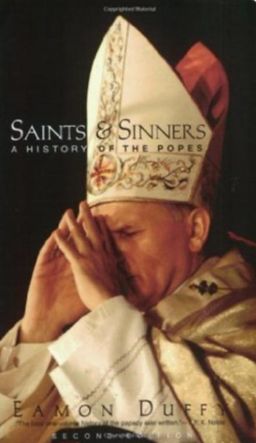Hakkında
Eamon Duffy is Professor of the History of Christianity at the University of Cambridge, and former President of Magdalene College.
He describes himself as a "cradle Catholic" and specializes in 15th to 17th century religious history of Britain. His work has done much to overturn the popular image of late-medieval Catholicism in England as moribund, and instead presents it as a vibrant cultural force. On weekdays from 22nd October to 2nd November 2007, he presented the BBC Radio 4 series "10 Popes Who Shook the World" - those popes featured were Peter, Leo I, Gregory I, Gregory VII, Innocent III, Paul III, Pius IX, Pius XII, John XXIII, and John Paul II.
Unvan:
Yazar
Doğum:
Dundalk, Irlanda, 9 Şubat 1947
Okurlar
1 okur okudu.
Kitaplar
Sözler ve Alıntılar
In 1482 the Turkish Prince Cem, younger son of Sultan Mehmet II, the conqueror of Constantinople, presented himself before the Knights of St John at Rhodes. Naively, he asked their help in overthrowing his brother Bayezit, who had succeeded Mehmet II. Instead of helping him, the Knights negotiated a deal with Bayezit, who paid handsomely to have his dangerous brother kept under lock and key. In 1486 Innocent VIII placed Cem under papal protection (having bought the prisoner from the Grand Master of the Knights of St John by making the latter a cardinal), and three years later established him in some style in the Castel Sant’ Angelo.
The Pope now became chief gaoler to the Sultan. Bayezit sent Innocent a gift of 120,000 crowns (almost equal to the total annual revenue of the papal state), and the relic of the Holy Lance which had pierced Christ’s side on Calvary. A special shrine was built for it in St Peter’s. Thereafter the Pope received an annual fee of 45,000 ducats to keep Cem in custody.
Gregory’s pontificate represents the highest point of papal aspiration to dominion over the secular world. Paradoxically, he achieved startlingly little in concrete terms. Most of the bishops he excommunicated and deposed remained tranquilly in office, Henry long outlived him, and the papal reform changed direction after him, away from the attempt to rule the rulers, and towards the strengthening of its hold over the Church itself. Yet, if he was defeated in the short term, the spirit of papal reform owed everything to him, for after him the papacy never receded from its claims to freedom from secular and political control in spiritual matters.
From 1931 the new Republican regime in Spain was increasingly hostile to the Church. With the outbreak of the Spanish Civil War in 1936 hostility turned to active persecution, and refugees flooded into Rome with accounts of Communist atrocities. The Nationalist opposition, by contrast, though also guilty of atrocity, and not originally noted for their piety, increasingly saw the Church as integral to their vision of Spain. They received the endorsement of all but one of the Spanish bishops in a joint pastoral in 1937, and despite General Franco’s murderous acts of repression, the papacy backed him.
Executed by the Romans as a pretender to the throne of Israel, Jesus' death and resurrection were interpreted by reference to the stories and prophecies of the Jewish scriptures, and much of the language in which it was proclaimed derived from and spoke to Jewish hopes and longings.
Disillusion came in 1848, the year of revolutions all over Europe. In Rome, the Pope responded to the dangerous revolutionary fervour by establishing an elected municipal government, and in March agreed a new constitution for the Papal States with an elected chamber capable of vetoing papal policy.
As the demand for the expulsion of Austria from Italy turned into a war, more and more Italians treated it as a Crusade, and called on the Pope to lead it. Pope refused. As father of all the faithful, he declared, he could take no part in making war on a Catholic nation: he would send no troops against Austria. He condemned the idea of a federal Italy led by the papacy, urging Italians to remain faithful to their princes.
Overnight, from being the most popular man in Italy, he became the most hated. Rome became increasingly ungovernable, and in November 1848 his lay Prime Minister, Pellegrino Rossi, was murdered on the steps of the Cancelleria. The Pope fled.
Rome erupted into revolution, and Garibaldi and Mazzini established themselves at the head of a fiercely anti-clerical republican regime. From Gaeta, Pio Nono called on the Catholic powers to restore him, and in July 1849 French troops duly took possession of Rome on his behalf. He himself re-entered Rome in April 1850. He never recovered from his exile of 1848, and for the rest of his life remained convinced that political concessions to democracy merely fuelled the fires of revolution. The liberal honeymoon was over.
İletiler
Henüz kayıt yok
Yorumlar ve İncelemeler
Henüz kayıt yok
